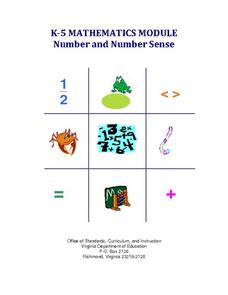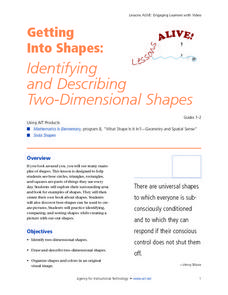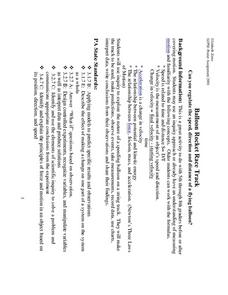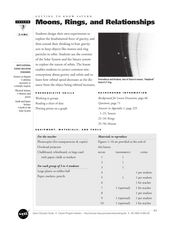Curated OER
K-5 Mathematics Module: Number and Number Sense
Reinforce number sense with a collection of math lessons for kindergarteners through fifth graders. Young mathematicians take part in hands-on activities, learning games, and complete skills-based worksheets to enhance proficiency...
Curated OER
What's in the Bag?
Help your students identify the attributes of two-dimensional shapes. They read the book Round is a Mooncake, and use pattern blocks to sort shapes. Students sort shapes according to their attributes.
Curated OER
Grammar Games and Activities
Thirty pages of grammar activities? Your young grammarians will be well versed in the parts of speech, basic verb tenses, and much more after completing even a handful of these exercises.
Arizona Department of Education
Area and Perimeter of Regular and Irregular Polygons
Extend young mathematicians' understanding of area with a geometry lesson on trapezoids. Building on their prior knowledge of rectangles and triangles, students learn how to calculate the area of trapezoids and other...
Curated OER
A Rectangular Prism and Its Net
Identify the nets for prisms and other geometric shapes. Learners calculate the surface area of the rectangular prism then sketch the shapes of prisms and other polygons. Unfolded cereal boxes are used as a visual aid, great idea!
Curated OER
Getting Into Shapes: Identifying and Describing Two-Dimensional Shapes
Young scholars examine their classroom to find examples of various types of shapes. After identifying and describing the various shapes, they draw as many as they can on a piece of paper. They organize them into an image based on their...
Curated OER
Graphing Linear Motion
For this graphing linear motion worksheet, students answer 20 questions about velocity of objects, the distance they travel and the time. They interpret a graph of position vs. time and identify the velocity at certain point on the graph.
Curated OER
Density And Volume
Sixth graders explore the concept of density as a relationship of an object's mass to its volume. Densities of a variety of objects are compared and used to identify an unknown object.
Curated OER
Acceleration
In this acceleration worksheet, high schoolers solve 14 problems including finding work done on an object, the speed of an object, the distance traveled and the acceleration.
Curated OER
Balloon Rocket Race Track
Students discuss "How can we measure (or make it easier to record) the speed, distance or acceleration of the balloon?" They told that they are going to make a balloon racetrack. Pupils use meter sticks to accurately measure length and...
Curated OER
Electricity
In this electricity worksheet, high schoolers answer 17 questions about charges on atoms, their number of protons and electrons, the attraction of atoms or objects when charged, the electricity between two objects, grounding and insulating.
Curated OER
Sound Energy
Sixth graders understand properties and behavior of heat, light, and sound. They describe the production of sound in terms of vibration of objects that create vibrations in other materials. Students describe how sound is made from...
Curated OER
Measurement Concepts practice 6.1
In this recognizing customary measurement concepts worksheet, students estimate and measure objects, determine whether measurement of an estimate is sufficient, make lists of objects with specific measurements, and solve word problems....
Curated OER
How to Haiku: Poetry Reflecting the Feelings in Art
Students discover the elements and subjects of haiku poetry. They observe and describe the objects in a landscape painting. They write a haiku based on the feelings evoked by the painting.
Curated OER
Throw and Run Challenge
Learners practice with various objects for throwing and catching (one per each group of 3 students); four poly spots or other markers such as cones for each group.
Curated OER
Linear Motion 5
In this linear motion activity, students answer 9 questions about velocity, acceleration and position of objects. They solve problems for acceleration and velocity and they interpret graphs of velocity vs. time, acceleration vs. time and...
Curated OER
Azimuth and Altitude
In this azimuth and altitude worksheet, students answer fifteen questions about measurements of objects in the sky using a compass and an inclinometer.
Curated OER
Momentum
In this momentum worksheet, high schoolers answer 17 questions about momentum of objects. They calculate momentum given mass and distance traveled in a given amount of time and they use graphs of position vs. time to find momentum.
Curated OER
Getting to Know Saturn: Moons, Rings, and Relationships
Students identify the different objects that orbit Saturn. In this space science instructional activity, students plot the graph of orbital speed and distance. They explain why planets and asteroids remain in orbit around the sun.
Curated OER
Linear Motion 2
In this linear motion worksheet, students answer 12 questions about displacement, velocity, and acceleration. They solve problems for acceleration, displacement and velocity and show the equations they used to find the solutions. They...
Curated OER
Classifying
In this classifying activity, students are given 8 rows of illustrations of animals. Students try out various ways to organize the animals in a classification system following the directions. They try a 2 groups system and a 3-5 group...
Curated OER
Linear Motion 6
For this linear motion worksheet, learners answer 12 questions about acceleration, velocity and distance traveled. They interpret diagrams and indicate the location of an object if it has positive, negative or no acceleration. They...
Curated OER
Density Columns
In this density worksheet, students answer 12 questions about the density of substances. They read a diagram of a graduated cylinder and determine the volume, mass of water. They interpret a diagram with three liquids and indicated their...
Curated OER
"Measurement in Motion"
Ninth graders examine the rate of motion and changes in motion using a ramp and a rolling object. They conduct the demonstration, determine the average speed, and describe how a moving object can have zero acceleration and deceleration.
Other popular searches
- Visualizing 3 D Objects
- 3 D Objects Activities
- 2 and 3 D Objects
- 3 D Objects Cones
- Comparing 3 D Objects
- Making 3 D Objects
- Geometry 3 D Objects
- Slicing 3 D Objects























